阿尔茨海默病,诊断标记物,脑脊液7
- 格式:pdf
- 大小:804.30 KB
- 文档页数:14
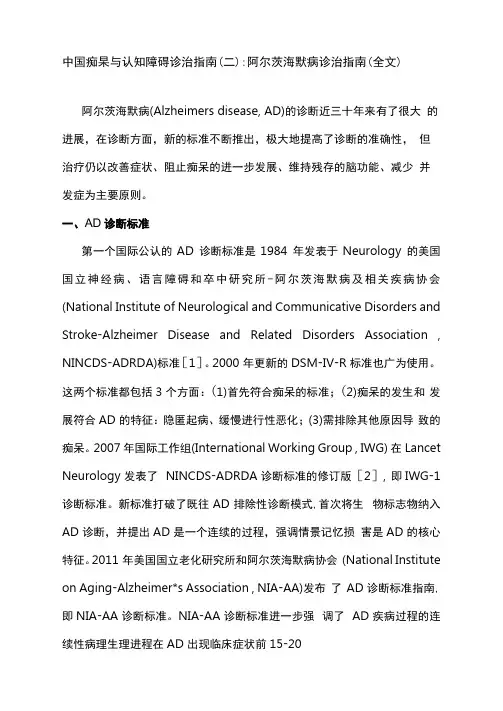
中国痴杲与认知障碍诊治指南(二):阿尔茨海默病诊治指南(全文)阿尔茨海默病(Alzheimers disease, AD)的诊断近三十年来有了很大的进展,在诊断方面,新的标准不断推出,极大地提高了诊断的准确性,但治疗仍以改善症状、阻止痴呆的进一步发展、维持残存的脑功能、减少并发症为主要原则。
一、AD诊断标准第一个国际公认的AD诊断标准是1984年发表于Neurology的美国国立神经病、语言障碍和卒中研究所-阿尔茨海默病及相关疾病协会(National Institute of Neurological and Communicative Disorders and Stroke-Alzheimer Disease and Related Disorders Association , NINCDS-ADRDA)标准[1]。
2000年更新的DSM-IV-R标准也广为使用。
这两个标准都包括3个方面:(1)首先符合痴呆的标准;(2)痴呆的发生和发展符合AD的特征:隐匿起病、缓慢进行性恶化;(3)需排除其他原因导致的痴呆。
2007 年国际工作组(International Working Group , IWG) 在Lancet Neurology发表了NINCDS-ADRDA诊断标准的修订版[2], 即IWG-1诊断标准。
新标准打破了既往AD排除性诊断模式,首次将生物标志物纳入AD诊断,并提出AD是一个连续的过程,强调情景记忆损害是AD的核心特征。
2011年美国国立老化硏究所和阿尔茨海默病协会(National Institute on Aging-Alzheimer*s Association , NIA-AA)发布了AD诊断标准指南,即NIA-AA诊断标准。
NIA-AA诊断标准进一步强调了AD疾病过程的连续性病理生理进程在AD出现临床症状前15-20年就已经开始,并将AD分为3个阶段,即AD临床前阶段[3]、AD源性轻度认知障碍[4]和AD痴呆阶段⑸。
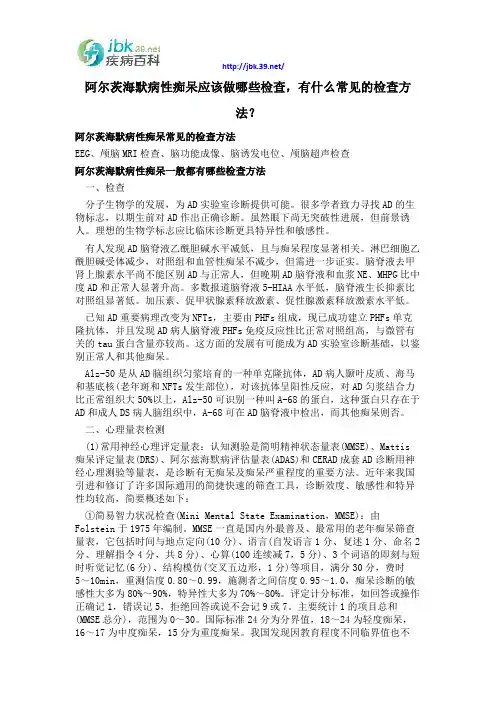
阿尔茨海默病性痴呆应该做哪些检查,有什么常见的检查方法?阿尔茨海默病性痴呆常见的检查方法EEG、颅脑MRI检查、脑功能成像、脑诱发电位、颅脑超声检查阿尔茨海默病性痴呆一般都有哪些检查方法一、检查分子生物学的发展,为AD实验室诊断提供可能。
很多学者致力寻找AD的生物标志,以期生前对AD作出正确诊断。
虽然眼下尚无突破性进展,但前景诱人。
理想的生物学标志应比临床诊断更具特异性和敏感性。
有人发现AD脑脊液乙酰胆碱水平减低,且与痴呆程度显著相关。
淋巴细胞乙酰胆碱受体减少,对照组和血管性痴呆不减少,但需进一步证实。
脑脊液去甲肾上腺素水平尚不能区别AD与正常人,但晚期AD脑脊液和血浆NE、MHPG比中度AD和正常人显著升高。
多数报道脑脊液5-HIAA水平低,脑脊液生长抑素比对照组显著低。
加压素、促甲状腺素释放激素、促性腺激素释放激素水平低。
已知AD重要病理改变为NFTs,主要由PHFs组成,现已成功建立PHFs单克隆抗体,并且发现AD病人脑脊液PHFs免疫反应性比正常对照组高,与微管有关的tau蛋白含量亦较高。
这方面的发展有可能成为AD实验室诊断基础,以鉴别正常人和其他痴呆。
Alz-50是从AD脑组织匀浆培育的一种单克隆抗体,AD病人颞叶皮质、海马和基底核(老年斑和NFTs发生部位),对该抗体呈阳性反应,对AD匀浆结合力比正常组织大50%以上,Alz-50可识别一种叫A-68的蛋白,这种蛋白只存在于AD和成人DS病人脑组织中,A-68可在AD脑脊液中检出,而其他痴呆则否。
二、心理量表检测(1)常用神经心理评定量表:认知测验是简明精神状态量表(MMSE)、Mattis 痴呆评定量表(DRS)、阿尔兹海默病评估量表(ADAS)和CERAD成套AD诊断用神经心理测验等量表,是诊断有无痴呆及痴呆严重程度的重要方法。
近年来我国引进和修订了许多国际通用的简捷快速的筛查工具,诊断效度、敏感性和特异性均较高,简要概述如下:①简易智力状况检查(Mini Mental State Examination,MMSE):由Folstein于1975年编制。
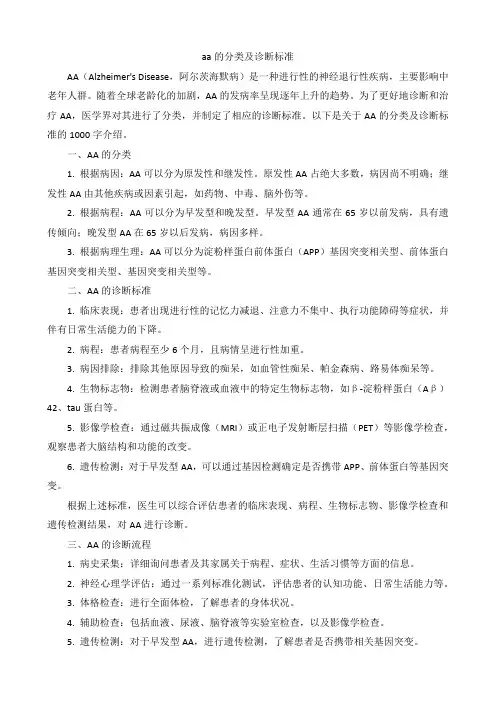
aa的分类及诊断标准AA(Alzheimer's Disease,阿尔茨海默病)是一种进行性的神经退行性疾病,主要影响中老年人群。
随着全球老龄化的加剧,AA的发病率呈现逐年上升的趋势。
为了更好地诊断和治疗AA,医学界对其进行了分类,并制定了相应的诊断标准。
以下是关于AA的分类及诊断标准的1000字介绍。
一、AA的分类1. 根据病因:AA可以分为原发性和继发性。
原发性AA占绝大多数,病因尚不明确;继发性AA由其他疾病或因素引起,如药物、中毒、脑外伤等。
2. 根据病程:AA可以分为早发型和晚发型。
早发型AA通常在65岁以前发病,具有遗传倾向;晚发型AA在65岁以后发病,病因多样。
3. 根据病理生理:AA可以分为淀粉样蛋白前体蛋白(APP)基因突变相关型、前体蛋白基因突变相关型、基因突变相关型等。
二、AA的诊断标准1. 临床表现:患者出现进行性的记忆力减退、注意力不集中、执行功能障碍等症状,并伴有日常生活能力的下降。
2. 病程:患者病程至少6个月,且病情呈进行性加重。
3. 病因排除:排除其他原因导致的痴呆,如血管性痴呆、帕金森病、路易体痴呆等。
4. 生物标志物:检测患者脑脊液或血液中的特定生物标志物,如β-淀粉样蛋白(Aβ)42、tau蛋白等。
5. 影像学检查:通过磁共振成像(MRI)或正电子发射断层扫描(PET)等影像学检查,观察患者大脑结构和功能的改变。
6. 遗传检测:对于早发型AA,可以通过基因检测确定是否携带APP、前体蛋白等基因突变。
根据上述标准,医生可以综合评估患者的临床表现、病程、生物标志物、影像学检查和遗传检测结果,对AA进行诊断。
三、AA的诊断流程1. 病史采集:详细询问患者及其家属关于病程、症状、生活习惯等方面的信息。
2. 神经心理学评估:通过一系列标准化测试,评估患者的认知功能、日常生活能力等。
3. 体格检查:进行全面体检,了解患者的身体状况。
4. 辅助检查:包括血液、尿液、脑脊液等实验室检查,以及影像学检查。

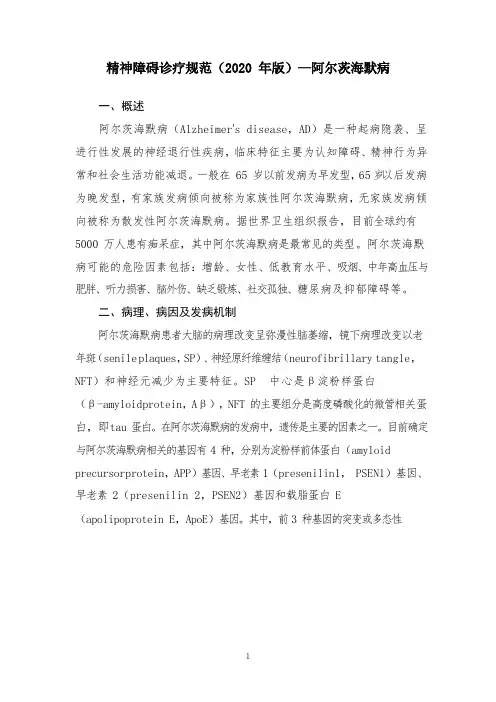
精神障碍诊疗规范(2020 年版)—阿尔茨海默病一、概述阿尔茨海默病(Alzheimer’s disease,AD)是一种起病隐袭、呈进行性发展的神经退行性疾病,临床特征主要为认知障碍、精神行为异常和社会生活功能减退。
一般在 65 岁以前发病为早发型,65 岁以后发病为晚发型,有家族发病倾向被称为家族性阿尔茨海默病,无家族发病倾向被称为散发性阿尔茨海默病。
据世界卫生组织报告,目前全球约有5000 万人患有痴呆症,其中阿尔茨海默病是最常见的类型。
阿尔茨海默病可能的危险因素包括:增龄、女性、低教育水平、吸烟、中年高血压与肥胖、听力损害、脑外伤、缺乏锻炼、社交孤独、糖尿病及抑郁障碍等。
二、病理、病因及发病机制阿尔茨海默病患者大脑的病理改变呈弥漫性脑萎缩,镜下病理改变以老年斑(senile plaques,SP)、神经原纤维缠结(neurofibrillary tangle,NFT)和神经元减少为主要特征。
SP 中心是β淀粉样蛋白(β-amyloid p rotein,Aβ),NFT 的主要组分是高度磷酸化的微管相关蛋白,即tau 蛋白。
在阿尔茨海默病的发病中,遗传是主要的因素之一。
目前确定与阿尔茨海默病相关的基因有4 种,分别为淀粉样前体蛋白(amyloid precursor p rotein,APP)基因、早老素1(presenilin 1, PSEN1)基因、早老素 2(presenilin 2,PSEN2)基因和载脂蛋白 E (apolipoprotein E,ApoE)基因。
其中,前3 种基因的突变或多态性与早发型家族性阿尔茨海默病的关系密切,ApoE 与散发性阿尔茨海默病的关系密切。
目前比较公认的阿尔茨海默病发病机制认为Aβ的生成和清除失衡是神经元变性和痴呆发生的始动因素,其可诱导tau 蛋白过度磷酸化、炎症反应、神经元死亡等一系列病理过程。
同时,阿尔茨海默病患者大脑中存在广泛的神经递质异常,包括乙酰胆碱系统、单胺系统、氨基酸类及神经肽等。




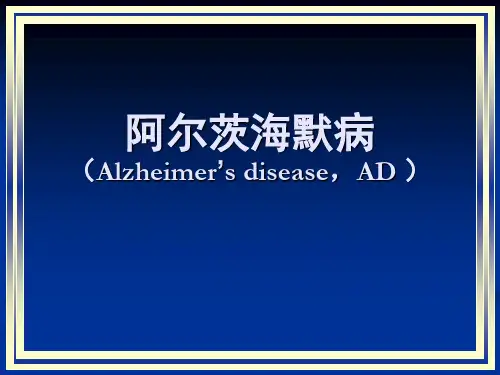
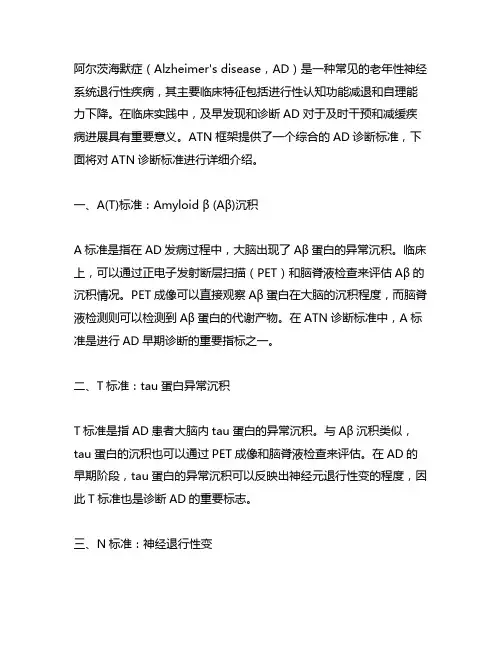
阿尔茨海默症(Alzheimer's disease,AD)是一种常见的老年性神经系统退行性疾病,其主要临床特征包括进行性认知功能减退和自理能力下降。
在临床实践中,及早发现和诊断AD对于及时干预和减缓疾病进展具有重要意义。
ATN框架提供了一个综合的AD诊断标准,下面将对ATN诊断标准进行详细介绍。
一、A(T)标准:Amyloid β (Aβ)沉积A标准是指在AD发病过程中,大脑出现了Aβ蛋白的异常沉积。
临床上,可以通过正电子发射断层扫描(PET)和脑脊液检查来评估Aβ的沉积情况。
PET成像可以直接观察Aβ蛋白在大脑的沉积程度,而脑脊液检测则可以检测到Aβ蛋白的代谢产物。
在ATN诊断标准中,A标准是进行AD早期诊断的重要指标之一。
二、T标准:tau蛋白异常沉积T标准是指AD患者大脑内tau蛋白的异常沉积。
与Aβ沉积类似,tau蛋白的沉积也可以通过PET成像和脑脊液检查来评估。
在AD的早期阶段,tau蛋白的异常沉积可以反映出神经元退行性变的程度,因此T标准也是诊断AD的重要标志。
三、N标准:神经退行性变N标准是指AD患者大脑内出现的神经退行性变。
这种变化通常可以通过结构性磁共振成像(MRI)来评估,其主要特征包括海马体和内侧颞叶皮层的萎缩以及脑室扩张。
神经退行性变的出现通常意味着AD 已经进入了中后期阶段,因此N标准在AD的临床诊断中具有重要意义。
通过ATN框架,医生不仅可以根据临床表现来诊断AD,还可以通过PET、脑脊液检查和MRI等检查手段全面评估患者的病情,并及早干预和治疗。
ATN框架还为科学研究提供了一个统一的诊断标准,有助于不同研究机构之间的数据比较和结果验证。
ATN框架为AD的诊断提供了一种标准化的方法,使得临床医生能够更准确地识别患者的病情,并采取针对性的干预措施。
随着越来越多的研究和临床实践的积累,相信ATN框架将会在AD的诊断和治疗中发挥越来越重要的作用。
在过去的几年中,随着对阿尔茨海默症的深入研究和了解的增加,ATN诊断标准也在不断完善和发展。
《中国痴呆与认知障碍诊治指南(二):阿尔茨海默病诊治指南》要点 阿尔兹海默病(AD)的诊断近三十年来有了很大的进展,在诊断方面,新的标准不断推出,极大地提高了诊断的准确性,但治疗仍以改善诊治。阻止痴呆的进一步发展、维持残存的脑功能、减少并发症为主要原则。
一、AD诊断标准 第一个发表于1984年国际公认的AD诊断标准和广为使用的2000年更新的DSM--R标准,这两个标准都包括3个方面: 首先符合痴呆的标准;痴呆的发生和发展符合AD的特征:隐匿起病、缓慢进行性恶化;需排除其他原因导致的痴呆。
2014年IWG发表了2007年IWG标准的修订版——IWG-2标准,首次将AD生物标志物分为诊断标志物和进展标志物。
以病理检查为金标准的研究发现NINCDS-ADRDA很可能AD标准的敏感度较高为83%~98%,但敏感度只有68%。
【推荐】 临床AD诊断可依据1984年NINCDS-ADRDA或2011版NIA-AA提出的AD诊断标准进行诊断。(专家共识) 有条件进行AD分子影像检查和脑脊液检测时,可依据2011版NIA-AA或2014版IWG-2诊断标准进行AD诊断。(专家共识)
应提高对不典型AD的诊断意识。(专家共识) 二、AD的治疗 (一)胆碱酯酶抑制剂(ChEIs) 是现今治疗轻中度AD的一线药物,主要包括多奈哌齐、卡巴拉汀、加兰他敏和石杉碱甲。
【推荐】 明确诊断为AD患者可以选用ChEIs治疗。(A级推荐) 应用某一胆碱酯酶抑制剂治疗无效或因不良反应不能耐受时,可根据患者病情及出现不良反应程度,调整其他ChEIs或换作贴剂进行治疗,治疗过程中严密观察患者可能出现的不良反应。(B级推荐) ChEIs存在剂量效应关系,中重度AD患者可选用高剂量的ChEIs作为治疗药物,但应遵循低剂量开始逐渐滴定的给药原则,并注意药物可能出现的不良反应。(专家共识)
(二)兴奋性氨基酸受体拮抗剂 盐酸美金刚是另一类一线药物,是FDA批准的第一个用于中重度痴呆治疗的药物。
神经系统疾病的生物标志物研究有哪些进展神经系统疾病是一类严重影响人类健康和生活质量的疾病,包括阿尔茨海默病、帕金森病、多发性硬化症、脑卒中等。
这些疾病的诊断和治疗往往具有挑战性,因为神经系统的复杂性和疾病的多样性。
生物标志物的发现和研究为神经系统疾病的早期诊断、病情监测、治疗反应评估以及疾病机制的理解提供了重要的线索和手段。
近年来,神经系统疾病的生物标志物研究取得了显著的进展,为改善疾病的管理和预后带来了新的希望。
一、蛋白质生物标志物蛋白质是细胞和生物体的重要组成部分,其表达和修饰的变化与神经系统疾病的发生和发展密切相关。
例如,在阿尔茨海默病中,β淀粉样蛋白(Aβ)和tau 蛋白是两个备受关注的生物标志物。
Aβ 在脑内的沉积形成斑块,而 tau 蛋白的过度磷酸化导致神经纤维缠结,它们的检测可以帮助早期诊断阿尔茨海默病。
脑脊液中Aβ42 和 tau 蛋白的水平,以及血浆中Aβ 相关的生物标志物,如Aβ40/Aβ42 比值,都具有一定的诊断价值。
帕金森病的生物标志物研究也集中在蛋白质方面。
α突触核蛋白是帕金森病的关键病理蛋白,其在脑脊液和血液中的检测有望成为帕金森病的诊断指标。
此外,一些炎症相关的蛋白质,如 C 反应蛋白、肿瘤坏死因子α等,也被发现与帕金森病的进展和病情严重程度有关。
二、基因生物标志物随着基因测序技术的发展,基因变异与神经系统疾病的关联研究不断深入。
一些基因突变已被确定为某些神经系统疾病的致病因素,如帕金森病中的 PARK 基因、阿尔茨海默病中的 APP、PSEN1 和 PSEN2 基因等。
通过基因检测,可以早期发现携带这些基因突变的个体,从而进行密切监测和预防性干预。
此外,基因表达谱的研究也为神经系统疾病的生物标志物发现提供了新的途径。
例如,通过对大脑组织或外周血中的基因表达进行分析,可以筛选出与疾病相关的差异表达基因,作为潜在的生物标志物。
三、代谢生物标志物代谢组学是研究生物体内代谢物变化的学科,在神经系统疾病的生物标志物研究中具有重要作用。
Journal of Alzheimer’s Disease31(2012)865–878DOI10.3233/JAD-2012-120211IOS Press865 The Load of Amyloid-Oligomersis Decreased in the Cerebrospinal Fluidof Alzheimer’s Disease PatientsGiulia M.Sancesario a,Maria T.Cencioni b,Zaira Esposito a,Giovanna Borsellino b,Marzia Nuccetelli a, Alessandro Martorana a,b,Luca Battistini b,Roberto Sorge a,Gianfranco Spalletta b,Davide Ferrazzoli a, Giorgio Bernardi a,b,Sergio Bernardini a and Giuseppe Sancesario a,b,∗a Tor Vergata General Hospital,Faculty of Medicine and Surgery,The University of Rome Tor Vergata,Rome,Italyb Santa Lucia Foundation,Rome,ItalyAccepted19May2012Abstract.Amyloid-(A)oligomers are heterogeneous and instable compounds of variable molecular weight.Flow cytometry andfluorescence resonance energy transfer(FRET)-based methods allow the simultaneous detection of Aoligomers with low and high molecular weight in their native form.We evaluated whether an estimate of different species of Aoligomers in the cerebrospinalfluid(CSF)with or without dilution with RIPA buffer could be more useful in the diagnosis of Alzheimer’s disease (AD)than the measurement of A42monomers,total tau(t-tau),and phosphorylated tau(p-tau).Increased t-tau(p<0.01)and p-tau(p<0.01),and decreased A42(p<0.01),were detected in the CSF of patients with AD(n=46),compared to patients with other dementia(OD)(n=35)or with other neurological disorders(OND)(n=56).In native CSF(n=137),the levels of Aoligomers were lower(p<0.05)in AD than in OD and OND patients;in addition,the ratio Aoligomers/p-tau was lower in AD than in OD(p<0.01)and OND(p<0.05)patients,yielding a sensitivity of75%and a specificity of64%.However, in CSF diluted with RIPA(n=30),Aoligomers appeared higher(p<0.05)in AD than in OND patients,suggesting they become partially disaggregated and more easily detectable after RIPA.In conclusion,FRET analysis in native CSF is essential to correctly determine the composition of Aoligomers.In this experimental setting,the simultaneous estimate of low and high molecular weight Aoligomers is as useful as the other biomarkers in the diagnosis of AD.The low amount of Aoligomers detected in native CSF of AD may be inversely related to their levels in the brain,as occurs for Amonomers,representing a biomarker for the amyloid pathogenic cascade.Keywords:A42,Alzheimer’s disease,amyloid-,biomarkers,cerebrospinalfluid,flow cytometry,fluorescence resonance energy transfer,FRET,oligomersINTRODUCTIONThe amyloid-peptides1-40and1-42(A40,A42) are physiological derivatives of the amyloid-protein precursor,a normal constituent of neuronal and glial membranes.Aoligomers are soluble aggregates of a ∗Correspondence to:Prof.Giuseppe Sancesario,Department of Systems Medicine,1Montpellier Street–00133Rome, Italy.Tel.:+39620903013;Fax:+39620903118;E-mail: sancesario@med.uniroma2.it.variable number of Amonomers and constitute the precursors of insoluble largefibrils that deposit in amy-loid plaques in the brain,representing,together with neurofibrillary tangles,the histological hallmarks of Alzheimer’s disease(AD).A42,and to a minor extent A40,oligomers have been regarded in recent years not just as the intermediate to Afibrils,but as a pri-mary pathological factor,affecting synapses’function and neuronal viability,and secondarily rising an amy-loidogenic cascade to the large insoluble Afibrils,and the formation of amyloid plaques and neurofibrillaryISSN1387-2877/12/$27.50©2012–IOS Press and the authors.All rights reserved866G.M.Sancesario et al./AβOligomers in CSFtangles[1–3].A soluble pool of A40and A42aggre-gates together with the large insoluble Afibrils can be extracted by analytical ultracentrifugation of tissue homogenates from the cerebral cortex of AD affected brains,demonstrating that soluble oligomeric Aspecies are intrinsic to the brain AD pathology[4–6]. The proposed role of Aoligomers in the brain pathology has stimulated an extensive search for their presence in the cerebrospinalfluid(CSF),since,unlike the insolublefibrils deposited in brain tissue,solu-ble oligomers can diffuse into the CSF.If detected in sensitive assays,they would constitute,in essence,a useful biomarker for the amyloid pathogenic cascade. An increase of Aoligomers in the CSF of AD patients would be expected as a corollary of their increased occurrence and neurotoxic role in the brain tissue. The detection of single Aaggregates in the CSF wasfirst observed usingfluorescence correla-tion spectroscopy,a very sensitive biophysical method, demonstrating the occurrence of a faster Aself assembly in the CSF of AD affected patients[7]. Although several methods have been recently devel-oped attempting to detect diffusible Aoligomers in CSF,their detection in the CSF has not been an easy task to be pursued for diagnostic purposes in the setting of common biomedical research institutions[8].San-tos and co-workers[9]published a very sensitive and specific method for the detection of different species of Aoligomers in the CSF of non-demented neurologi-cal patients,based on afluorescence resonance energy transfer(FRET)setup,and subsequent detection by flow cytometry.We used FRET andflow cytometric analysis and unexpectedly found that levels of Aoligomers are lower in the CSF of probable AD than in control patients in contrast to the results recently reported by Santos et al.[10].Thesefindings raise the possibility that the detectability of Aoligomers with the FRET cytometric analysis could be dependent on different pre-analytical and analytical factors.We sought to val-idate the quantitative reproducibility of storage and detection procedures of oligomers by FRET cytometric analysis,andfinally we evaluated whether an estimate of oligomer Aspecies in their native form in the CSF could be more useful in the diagnosis of AD than Amonomers and tau.PATIENTS AND METHODSOne hundred and thirty seven patients were included in this study after admission to the Neurological Centre of the Tor Vergata General Hospital between2009 and2011because of cognitive or motor impairments. Exclusion criteria were acute trauma of the head and of the spinal cord,chronic subdural hematoma, hydrocephalus,brain tumors and paraneoplastic neu-rological syndrome,acute and chronic infections of the CNS,vitamin deficiency,hypothyroidism,liver and kidney insufficiency,or rmed written consent was obtained from each patient or relatives for routine clinical and instrumental investigations. The study was conducted under the guidelines of Hip-pocrates deontology and following approval of the local Ethical Committee.Clinical evaluationMedical history,thorough clinical and neurolog-ical investigation,Mini-Mental State Examination (MMSE),complete blood screening,electrocardio-gram,electroencephalogram,and magnetic resonance imaging of the brain were performed on all patients.A more comprehensive neuropsychological and psy-chiatric examination was performed on patients with cognitive deficit,using the standardized Mental Dete-rioration Battery[11]and the Hamilton Rating scale [12].Moreover,CSF was obtained as part of routine clinical evaluation;A42,total tau(t-tau),and phos-phorylated tau(p-tau)were measured for differential diagnosis of dementia[13,14].Patients werefirst divided in two groups:patients with different degrees of cognitive impairment (demented,MMSE=18.2±6.1)and patients without cognitive impairment(non demented, MMSE=27.8±1.2).The non demented group (n=56;40women,16men)included patients with heterogeneous neurological diseases:arterial hypertension and chronic ischemic encephalopathy (n=9),Parkinson’s disease without cognitive impair-ment(n=13),cerebellar atrophy(n=3),familial tremor(n=3),late onset epilepsy(n=5),spondilo-genetic mielopathy(n=4),optic papillitis(n=1), Sjogren syndrome(n=1),peripheral neuropathies (n=7),pseudotumor cerebri(n=2),narcolepsy(1), depressive pseudo-dementia(n=6),and psycho-somatic syndrome(n=1).Demented patients were further classified,according to clinical criteria,as affected by probable AD(n=46;27women,19 men;MMSE=20.1±6.5)and patients affected by other dementias(n=35;14women,21men; MMSE=15.5±3.8).The latter group consisted of patients affected by vascular dementia(n=15), frontotemporal dementia(n=1),Creutzfeldt-JacobG.M.Sancesario et al./AβOligomers in CSF867disease(n=1),Parkinson’s disease with dementia (n=14),progressive supranuclear palsy(n=1), amyotrophic lateral sclerosis with dementia(n=1), and chronic depressive state(n=2).The diagnosis of probable AD was made according to the DSM IV and NINCDS-ADRA guidelines[15].Diagnosis of frontotemporal dementia was suggested accord-ing to neuropsychological deficits and behavioral symptoms[16].Diagnosis of probable vascular dementia included patients according to NINDS-AIREN criteria[17].Clinical and neuropsychological examination was repeated six months later in each patient to check the clinical course and accuracy of the diagnosis.CSF withdrawalLumbar punctures were performed following stan-dard procedures.Briefly,the skin in the lumbar area was cleansed with povidone-iodine solution10%, and local anesthesia was induced with ethyl chlo-ride.A20-gauge needle was inserted at the L3/L4 or L4/L5interspaces while the patients were at bed rest in the lateral decubitus or in the sitting position. 6–8ml were routinely drained in three consecutive polypropylene tubes without preservative,and imme-diately carried to the chemistry department.Blood samples were taken at the same time to evaluate blood-brain albumin ratio and blood-brain barrier integrity. Polypropylene tubes(Eppendorf Safe-Lock tubes) and polypropylene pipette tips(Gilson-DIAMOND Tips)were used in the collection and storage of CSF [18].One CSF sample from each patient was used for routine chemical analysis and microscopic observa-tion.Patients with blood contaminated CSF samples containing>500erythrocytes/l were excluded from this study.CSF samples were centrifuged(2000rpm) at4◦C for10min,divided in aliquots of300l,and stored at–80◦C within2h after withdrawal.Within1 to3months after freezing,the samples were thawed just once and immediately handled for the detection of Aoligomers and for the measurements of A42, t-tau,and p-tau.Aβ42,t-tau and p-tau measurementsThe levels of A42,t-tau,and p-tau,classical biomarkers in CSF,were determined according to pre-viously published standard procedures[19,20],using commercially available sandwich enzyme-linked immunosorbent assays(ELISA)(Innotest-Amyloid 1-42,Innotest h-T-tau,Innotest PhosphoT-tau–Inno-genetics).Preparation of AβaggregatesWe obtained aggregates from Amonomers using Dahlgren’s modification of Lambert’s protocol[21, 22].Recombinant A42and synthetic A40were purchased respectively from rPeptide(Athens,GA) and American Peptide(Sunnyvale,CA).Both A40 and A42monomers(1mg)were dissolved in anhy-drous dimethyl sulfoxide to5mM,and sonicated for 10min.Thereafter,the monomeric Asolutions were diluted to100M either in cold HAM’s-F12cul-ture medium(Euroclone)and incubated over night at 4◦C for oligomer formation,or in HCl10mM and incubated at37◦C overnight forfibril formation.All samples were then stored at−20◦C.Analysis of synthetic AβaggregatesFrozen oligomer andfibril preparations were thawed just once,and used to confirm the formation of Aaggregates by SDS-PAGE analysis without heat denat-uration followed by silver staining.Monomers and aggregated forms of A40and A42,corresponding to an original content of1g of monomers for each sample,were separated in16%SDS-PAGE tris-tricine buffer(5ml Acrylamide Bis/tri33%,0.88ml Glyc-erol,3.3ml Tris-HCl3M pH8.45,1ml SDS1%, 100l APS10%,10l TEMED).Polypeptide SDS PAGE molecular weight standards(Bio-Rad)were included as reference.After run,gels werefixed in 40%methanol and10%acetic acid over night,and then were silver stained(Bio-Rad Silver Stain kit).Densit-ometric analysis of scanned blots was performed using the NIH ImageJ version l.29program(NIH,Bethesda, MD,USA).Fluorescence labeling of antibodiesThe monoclonal Aantibodies4G8(Chemicon) and6E10(Covance),recognizing different epitopes of the Apeptide(17-24and1-16,respectively), were labeled respectively with thefluorescent chro-mophores Alexa Fluor488and Alexa Fluor594using the Monoclonal Antibody Labeling Kit(Invitrogen), following manufacturer’s instructions.868G.M.Sancesario et al./AβOligomers in CSFFRET andflow cytometric analysisExtensive FRET analysis was carried out in frozen samples of native CSF(n=137)and of synthetic oligomer andfibril preparations;frozen samples were thawed just once and directly incubated with 4G8-Alexa Fluor488(2nM)and6E10-Alexa Fluor 594.Moreover,some CSF samples(n=15of patients with AD,and n=15with other neurological disor-ders(OND))were studied in duplicate to evaluate the interference of dilution and detergents on detec-tion of oligomers.To this purpose,two CSF aliquots of each patient were studied:the undiluted one (defined as native)was directly incubated withfluo-rescent antibodies,according to our protocol,whereas the other was preliminary diluted(1:1)with RIPA buffer which contains both non ionic(0.5%NP-40and0.25%deoxycholate)and ionic detergents (SDS0.05%)according to Santos et al.[9,10]. Furthermore,in a separate and adjunctive group of patients(n=5)FRET analysis was carried out in duplicate in fresh native CSF samples incubated withfluorescent antibodies within2h after lum-bar puncture,as well as after one freezing-thawing cycle.Equal volumes(300l)of native or diluted CSF, of synthetic A40and A42monomers,and of Aaggregate preparations(corresponding to an original content of0.1g of monomers for each sample)were incubated for90min at4◦C with4G8-Alexa Fluor 488(2nM)and6E10-Alexa Fluor594(8nM),accord-ing to Santos et al.[9].CSF samples and standard in vitro Aaggregates were analyzed for monomer and oligomer content with a FACS Calibur cytome-ter(BD biosciences).FRET analysis was acquired from samples incubated either with thefluorescent chromophores Alexa Fluor488and Alexa Fluor594 (blank),or with thefluorescent antibody4G8-Alexa Fluor488only or with6E10-Alexa Fluor594,and finally with bothfluorescent antibodies.FRET involves the energy transfer between twofluorescent chro-mophores,from the excited donor molecule,Alexa Fluor488,to the acceptor molecule,Alexa Fluor594. The FRET can occur only if the distance between the two chromophore-carrying antibodies is less than 10nm,that is the distance between the donor and acceptor probe at which the energy transfer is(on average)50%efficient(F¨o rster distance).According to Santos et al.[9],oligomer particles were gated in logarithmic forward/side scatter dot plot(FSC ver-sus SSC).The green or redfluorescence respectively of the dyes Alexa Fluor488and Alexa Fluor594were detected in logarithmic scale by the correspond-ing FL1and FL3photomultipliers through530/30 or670LP bandpassfilter,respectively.To avoid dif-ference in analysis,known number of Count Bright absolute counting beads(Invitrogen)were added to all sample and gated in logarithmic FL4/SSC dot. Incubation of synthetic Aβ42oligomers in human CSFTo evaluate the stability of A42oligomers in human CSF,known amounts of synthetic A42oligomers were incubated in CSF of control(n=5)and AD patients(n=5).Briefly,synthetic A42oligomer preparation,corresponding to an original content of 0.5g monomers,was diluted to25M in native CSF 300l of AD and control patients,and incubated at 37◦for5h.SDS PAGE was used to determine the frequency distribution of synthetic A42monomers and oligomers:samples of control and probable AD patients were run in duplicate in16%tris-tricine SDS-PAGE at room temperature.After the run,the gels were alternativelyfixed in40%methanol and10% acetic acid for silver staining(Bio-Rad),or were trans-ferred onto nitrocellulose membrane in Tris glycine 20%methanol for western blot.Thereafter,nitrocellu-lose membranes were boiled3min in distilled H2O, blocked in3%BSA,and probed with the mono-clonal anti Aantibody6E10(Covance)at a1:2,000 dilution in PBS at4◦C overnight.Bound antibodies were detected by incubation for2h at room tem-perature with an HRP-conjugated secondary antibody (DAKO)1:10,000in PBS.HRP reaction products were detected using the ECL system(Perkin Elmer), followed by ChemiDoc acquisition(Bio-Rad).Densit-ometric analysis of scanned blots was performed using the NIH ImageJ version l.29program(NIH,Bethesda, MD,USA).Statistical analysisAll data analysis was performed using the Statistical Package for the Social Sciences Windows,version17.0 (SPSS,Chicago,Illinois,USA).Descriptive statistics consisted in the mean±SD for variables with Gaus-sian distributions after confirmation with histograms and the Kolgomorov-Smirnov test,or median(min-max)for parameter categorical(non–parameters).The homogeneity of the variance was evaluated with Lev-ene’s test.One-way analysis of variance(ANOV A) and test for multiple comparison(Bonferroni test) was used to evaluate significant differences amongG.M.Sancesario et al./A βOligomers in CSF 869groups.Receiver operating characteristic (ROC)curveanalysis determined cut-off of sensibility and speci-ficity of the data.Statistical significance was set atp value <0.05.RESULTSSynthetic A βoligomersSilver stained SDS polyacrylamide gels were usedto distinguish aggregated species of synthetic A 40and A 42after applying the oligomer-or fibril-forming conditions.Analysis of the A 40gel showeda large band of monomers (∼3.5kDa)and an unspe-cific (∼9kDa)band equally detectable under differentexperimental conditions (Fig.1A).Analysis of theA 42gel showed an heterogeneous complex ofmonomers and oligomers of different sizes depend-ing on the experimental conditions (Fig.1B):oligomerpreparations contain monomer,tetramer,and pentamerbands of ∼14–17kDa,corresponding to low molecularweight (LMW)oligomers;fibril preparations containmonomer and tetramer bands,and large aggregatesof 27and ∼50–100kDa,which correspond to highmolecular weight (HMW)oligomers.The presenceof fibrils in the fibril preparation was not,however,detected by SDS-PAGE and immunoblotting:fibrilsinstead could be visualized by electron microscopyand atomic force microscopy according to previousworks [21,22].Although it is not possible to equatestructural A 42oligomer species observed in vitro andin CSF,it is worth noting that A 42fibril prepara-tion contains A 42monomers,and LMW as well asHMW oligomers,corresponding at least in part to theheterogeneous molecular size of the oligomer mixturedetected in CSF[23].Fig.1.SDS-PAGE and silver staining of synthetic A 40(A),andA 42(B),corresponding to an original content of 1g of monomers,in monomeric (lane 1),fibril (lane 2),or oligomeric preparations(lane 3).M =molecular weight markers.FRET and Flow cytometric analysis of in vitro formed A βaggregates The particles positive only for 4G8-Alexa Fluor 488can be detected by the FL1photomultiplier through a 530/30bandpass filter,while the particles posi-tive for both 4G8-Alexa 488and 6E10-Alexa 594can be detected by FL3photomultiplier through the 670LP bandpass filter,and can be identified as cor-responding to FRET events indicative of oligomer particles (Fig.2).FRET analysis readily distinguishes A monomer and A aggregate preparations.Sam-ples containing synthetic A 42monomers did not show detectable FRET signal after incubation with both monoclonal 4G8and 6E10anti-A antibodies,labeled respectively with Alexa Fluor 488or Alexa Fluor 594(data not shown).Moreover,no FRET signals were detected in samples containing A 42oligomer preparation after incubation either with both chromophores Alexa Fluor 488and Alexa Fluor 594not bound to anti-A antibodies (Fig.2A),or after incubation with just one labeled antibody,i.e.,4G8-Alexa Fluor 488or 6E10-Alexa Fluor 594separately (Fig.2B,C,E).On the contrary,after incubation with both anti-A antibodies 4G8-Alexa Fluor 488and 6E10-Alexa Fluor 594,the samples of oligomer and fibril preparations displayed highly specific FRET signals in the FL3photomultiplier (670LP),indica-tive of single A aggregates and of their numbers in the sample (Fig.2D,F).FRET signal intensity was stronger for fibril preparation,containing both LMW and HMW oligomers (Fig.2F),compared to oligomer preparation containing LMW oligomers only (Fig.2D).However,it is not presently clear whether fibrils in fibril preparation remain in solution and are efficiently detected by FRET signals.Anyway,fibril preparations were more stable than oligomer prepa-rations and were used to assess the sensitivity of the assay.As shown by Santos et al.[9],FRET signals are dose-dependent and linear for the concentrations of monomers used for A 42aggregates,ranging between 10pM to 2.0nM (Fig.3).Although estimation of the A oligomer size is possible due to FRET signal intensity of each single particle [24],characteriza-tion of the molecular size of the detected particles cannot be easily inferred among a multiplicity of FRET signals.Moreover,a reliable internal standard for the detection of A oligomer is presently not avail-able,since both natural and synthetic A oligomer mixtures are heterogeneous,composed by variable species of different molecular sizes and conforma-tions.Therefore,our FRET analysis is not indicative870G.M.Sancesario et al./AβOligomers in CSFFig.2.Flow cytometric detection of A42oligomers prepared in vitro(original content of0.1g of monomers).Fluorescent signals are represented as black spots.The FRET signals were detected by the FL3photomultiplier(670LP bandpassfilter)and represented toward the middle of each graph if the acceptor Alexa Fluor594was excited by a very close donor Alexa Fluor488,whose signals were instead only detected by the FL1photomultiplier(530/30bandpassfilter)and represented on the left of each graph.A–D)Samples of A42oligomer preparations after:A)fluorescent chromophores Alexa Fluor488and Alexa Fluor594,or B)4G8-Alexa Fluor488,or C)6E10-Alexa Fluor594labeled antibodies were added separately,or D)4G8-Alexa Fluor488and6E10-Alexa Fluor594labeled antibodies were added in combination.E, F)Samples of A42fibril preparations after the6E10-Alexa Fluor594acceptor antibody was added alone(E),or in combination with the 4G8-Alexa Fluor488labeled antibody(F).The numbers reported on the corners of eachfigure represent the percentage offluorescent signals detected in each channel respective of the total of thefluorescent signals detected on the whole sample.G.M.Sancesario et al./AβOligomers in CSF871Fig.3.Sensitivity of the detection of A42oligomers infibril prepa-ration byflow cytometric analysis.A42oligomers were prepared in vitr o usingfibril preparation as described in methods,and progres-sively diluted from2nmol to10pmol(original content of0.1g of monomers).All data points represent mean values(±standard error) of measurements performed in triplicate.of the molecular size of the detected oligomers in the samples.FRET andflow cytometric analysis of native CSF Human CSF incubated with both chromophores Alexa Fluor488and Alexa Fluor594did not emitfluo-rescent signals(Fig.4A).Incubation of CSF with one labeled antibody plus a cromophore,i.e.,4G8-Alexa Fluor488plus Alexa Fluor594or with6E10-Alexa Fluor594plus Alexa Fluor488,displayedfluorescence signals in the FL1photomultiplier only,as expected (Fig.4B,C).Incubation of CSF with both labeled antibodies4G8-Alexa Fluor488and with6E10-Alexa Fluor594showedfluorescence signals in the FL3pho-tomultiplier,detecting the energy transfer of FRET events between contiguous donor and acceptor probes, and demonstrating the presence of Aoligomers in human CSF(Fig.4D).The quantitative evaluation of FRET signals in CSF samples from control and AD patients’groups pre-sented a large variation in the amount of detected oligomers(Fig.5).In order to avoid differences in the measurements due to uncontrolled variations in vol-ume of the CSF samples and of other undetermined variables,FRET events in each sample were normal-ized to the amounts of Count Bright absolute counting beads detected in the same sample.In restricting the analysis to the relationship between the AFRET events relative to the counting beads,we unexpectedly found that the levels of Aoligomers were lower in the CSF of probable AD patients than in OND and other dementia(OD)patients(p<0.05)(Fig.6B). Relationship between Aβoligomers and other biomarkers of ADLow levels of CSF Aoligomers were detected in AD patients in the early as well as in the late stage of the cognitive impairment assessed with MMSE scores(data not shown),even though the number of AD patients in the different severity stages in our study is insufficient to clarify whether CSF oligomers could be related to the disease progression.To vali-date our results with other investigated biomarkers for AD,we also measured the levels of monomeric A42, t-tau,and p-tau in this set of samples as detected by ELISA.Consistent with previous reports,increased t-tau(p<0.01)and p-tau(p<0.01),and decreased A42(p<0.01and p<0.05)levels were detected in the CSF of patients with probable AD,compared to OND and to OD patients,respectively(Fig.6A,C,E). The values of A42,t-tau,and p-tau detected in our lab were within the confidence interval of the average±2 SD in the external quality control program for CSF biomarkers of the Alzheimer’s Association[25]. Thereafter,we studied whether any relationship exists between Aoligomers detected by FRET and the other biomarkers of AD detected by ELISA. According to Santos et al.[9]and Fukumoto et al.[23],the ratio between Aoligomers and monomeric A42in CSF was not significant(data not shown). Conversely,the ratio of Aoligomers/t-tau was significantly lower in the CSF of patients with probable AD compared to the OND control group (p<0.01)but not to the OD group(Fig.6D);the ratio of Aoligomers/p-tau was significantly lower in AD patients compared to OND control(p<0.05) as well as to OD patients(p<0.01)(Fig.6F).We next performed ROC curve analysis to assess the ability of the ratio Aoligomers/t-tau or Aoligomers/p-tau to discriminate the patients with probable AD from the other two groups.The cutoff level of0.40for the ratio Aoligomers/t-tau yielded a sensitivity of78% and a specificity of71%,while a cutoff level of2.50 for the ratio Aoligomers/p-tau yielded a sensitivity of75%but a specificity of64%.Such values were comparable to sensitivity and specificity yielded by the other biomarkers alone or in combination in our study:Amonomer sensitivity78%,specificity65%; t-tau sensitivity80%,specificity62%;p-tau sensitivity 80%,specificity63%;Amonomers/t-tau sensitivity872G.M.Sancesario et al./A βOligomers inCSFFig.4.Representative flow cytometric detection of A 42native oligomers in CSF samples.A)CSF with fluorescent chromophores Alexa Fluor 488and Alexa Fluor 594.B–D)CSF after 4G8-Alexa Fluor 488(B),or 6E10-Alexa Fluor 594(C)labeled antibodies were added separately,or(D)in combination.Significant FRET signals were detected by the FL3photomultiplier (670LP bandpass filter)only in D.78%,specificity 71%;A monomers/p-tau sensitivity80%,specificity 62%.Influence of CSF sample preparation on A βoligomersTo examine whether the RIPA buffer,which wasused in the original protocol of Santos et al.[9,10],could affect the detection of A oligomers,we alsoconducted FRET analysis in duplicate in native CSFand in CSF diluted with RIPA buffer,using CSF sam-ples obtained from 30individuals (15patients withAD,and 15with OND).Taking into account the dilu-tion of CSF with RIPA (1:1)compared to native CSF,there was no correspondence between the two ana-lytical procedures since most of the data set of CSF diluted with RIPA lie above the identity line in a scatter diagram of pooled data from AD and control patients (Fig.7A)(p <0.01);indeed,the aliquots of CSF diluted with RIPA showed a concentration of A oligomers significantly higher than the aliquots of native CSF from the same individuals examined at the same time (Fig.7B).Moreover,the influence of CSF prepara-tions was comparatively evaluated in the AD and OND group.In native CSF,the levels of A oligomers were not significantly different between the two groups due to the large standard deviation and to the small sample size of this subset of patients (Fig.7C).Conversely,the levels of A oligomers in the CSF aliquots diluted with RIPA were significantly higher for AD compared to OND patients (p <0.05):RIPA buffer increases the overall amount of A oligomers and reduces the large。